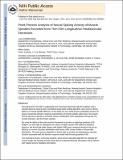| dc.contributor.author | Citi, Luca | |
| dc.contributor.author | Djilas, Milan | |
| dc.contributor.author | Azevedo-Coste, Christine | |
| dc.contributor.author | Yoshida, Ken | |
| dc.contributor.author | Brown, Emery N. | |
| dc.contributor.author | Barbieri, Riccardo | |
| dc.date.accessioned | 2012-04-19T16:08:35Z | |
| dc.date.available | 2012-04-19T16:08:35Z | |
| dc.date.issued | 2011-08 | |
| dc.date.submitted | 2011-04 | |
| dc.identifier.isbn | 978-1-4244-4122-8 | |
| dc.identifier.issn | 1557-170X | |
| dc.identifier.uri | http://hdl.handle.net/1721.1/70063 | |
| dc.description.abstract | Recordings from thin-film Longitudinal Intra-Fascicular Electrodes (tfLIFE) together with a wavelet-based de-noising and a correlation-based spike sorting algorithm, give access to firing patterns of muscle spindle afferents. In this study we use a point process probability structure to assess mechanical stimulus-response characteristics of muscle spindle spike trains. We assume that the stimulus intensity is primarily a linear combination of the spontaneous firing rate, the muscle extension, and the stretch velocity. By using the ability of the point process framework to provide an objective goodness of fit analysis, we were able to distinguish two classes of spike clusters with different statistical structure. We found that spike clusters with higher SNR have a temporal structure that can be fitted by an inverse Gaussian distribution while lower SNR clusters follow a Poisson-like distribution. The point process algorithm is further able to provide the instantaneous intensity function associated with the stimulus-response model with the best goodness of fit. This important result is a first step towards a point process decoding algorithm to estimate the muscle length and possibly provide closed loop Functional Electrical Stimulation (FES) systems with natural sensory feedback information. | en_US |
| dc.description.sponsorship | National Institutes of Health (U.S.) (Grant R01-HL084502) | en_US |
| dc.description.sponsorship | National Institutes of Health (U.S.) (Grant DP1-OD003646) | en_US |
| dc.language.iso | en_US | |
| dc.publisher | Institute of Electrical and Electronics Engineers | en_US |
| dc.relation.isversionof | http://dx.doi.org/10.1109/IEMBS.2011.6090581 | en_US |
| dc.rights | Creative Commons Attribution-Noncommercial-Share Alike 3.0 | en_US |
| dc.rights.uri | http://creativecommons.org/licenses/by-nc-sa/3.0/ | en_US |
| dc.source | PubMed Central | en_US |
| dc.title | Point-process analysis of neural spiking activity of muscle spindles recorded from thin-film longitudinal intrafascicular electrodes | en_US |
| dc.type | Article | en_US |
| dc.identifier.citation | Citi, L. et al. “Point-process Analysis of Neural Spiking Activity of Muscle Spindles Recorded from Thin-film Longitudinal Intrafascicular Electrodes.” IEEE, 2011. 2311–2314. Web. | en_US |
| dc.contributor.department | Massachusetts Institute of Technology. Department of Brain and Cognitive Sciences | en_US |
| dc.contributor.approver | Brown, Emery N. | |
| dc.contributor.mitauthor | Brown, Emery N. | |
| dc.contributor.mitauthor | Citi, Luca | |
| dc.contributor.mitauthor | Barbieri, Riccardo | |
| dc.relation.journal | Proceedings of the 33rd Annual International Conference of the IEEE Engineering in Medicine and Biology Society, EMBC 2011 | en_US |
| dc.eprint.version | Author's final manuscript | en_US |
| dc.type.uri | http://purl.org/eprint/type/JournalArticle | en_US |
| eprint.status | http://purl.org/eprint/status/PeerReviewed | en_US |
| dspace.orderedauthors | Citi, L.; Djilas, M.; Azevedo-Coste, C.; Yoshida, K.; Brown, E. N.; Barbieri, R. | en |
| dc.identifier.orcid | https://orcid.org/0000-0003-2668-7819 | |
| dc.identifier.orcid | https://orcid.org/0000-0002-6166-448X | |
| mit.license | OPEN_ACCESS_POLICY | en_US |
| mit.metadata.status | Complete | |
